Description and biology
Short’s goldenrod is an herb that grows to 24 to 30 inches (61 to 76 centimeters) high. It is classified as a perennial (plant that lives, grows, flowers, and produces seeds for three or more consecutive years). During the growing season, its underground stem may produce as many as six other separate stems that will create new plants.
The plant’s leaves grow along the stem alternately (each leaf is attached to the stem on the side opposite to that of the leaf growing immediately above and below it).
The leaves are narrow, measuring 2 to 4 inches (5 to 10 centimeters) long and 0.2 to 0.6 inch (0.5 to 1.5 centimeters) wide. Those leaves growing near the middle of the stem are larger than those growing toward each end.
  |
The goldenrod’s yellow flowers, which are gathered in clusters of ten or more, bloom from mid–August to early November. Seeds are released from late September to late November. Botanists (people specializing in the study of plants) believe the sweat bee and other insects pollinate the plant when they seek out the flowers’ nectar.
Habitat and current distribution
This species of goldenrod is unique to Kentucky. Five populations exist, the largest of which lies within Blue Licks Battlefield State Park. The other four populations are within a 2–mile (3.2–kilometer) radius of the park. Botanists estimate the total population to be between 3,400 and 4,000 individual plants.
Short’s goldenrod inhabits cedar glades, pastures, and open areas in oak and hickory forests.
History and conservation measures
Short’s goldenrod was first identified in 1842 in a site near the Ohio River in Jefferson County, Kentucky. All plants at that site were later destroyed when the site was flooded as a result of dam construction.
The primary threat to Short’s goldenrod is the loss of its habitat due to human activities and fire (both man–made and natural). Overcollection by scientists is an additional threat.
Part of the Blue Licks Battlefield State Park has been designated a nature reserve to protect Short’s goldenrod. Most remaining populations are on private land. To ensure the survival of this plant species, it is necessary that private landowners cooperate with any conservation measures.

